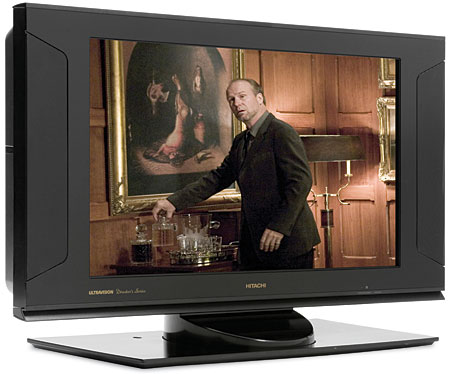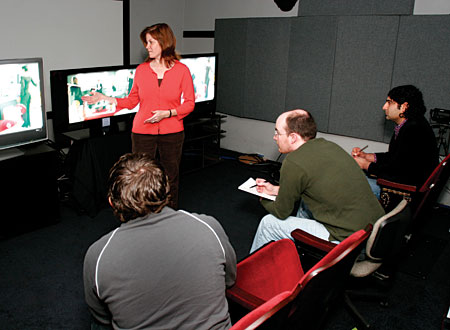HT's Inaugural LCD Face Off Hitachi 32HLX61 LCD HDTV
It's OK to be different.
The Hitachi 32HLX61 hails from their higher-end Director's Series, which represents the best technology, build quality, and features that Hitachi has to offer. That's why this 32-inch LCD costs more than both the 37- and 40-inch models we pitted against it. It was the only TV in the group that housed all of the connections in a separate AV Control Center box that resides in your gear rack, minimizing the number of cables you need to run to the panel itself.

What I found most enticing about this LCD was that it uses Hitachi's new Advanced Super In-Plane Switching technology to address two common LCD performance drawbacks—namely, viewing angle and motion blur. (See Geoffrey Morrison's GearWorks in this issue for more on this new technology.) Would our participants notice a difference? In a word, yes.
Everyone noted that the Hitachi 32HLX61 did the best job retaining the shape of the moving cue ball in our motion-blur test. In the 1080i basketball sequence, background faces retained some distinction when the camera panned across them, compared with the other two displays, which blurred the fine detail.
It also had the best viewing angle with most material. I say "most material," because I noticed an interesting difference with the AS-IPS screen versus the others. With an all-black test pattern, the Hitachi screen had a glossy sheen and some noticeable uniformity issues, creating patches of purple. This caused the darkest parts of our Corpse Bride and Chicago scenes to look a bit washed out from an extreme angle; however, normal to bright scenes retained their saturation much better than the other two TVs.

According to Hitachi, the 32HLX61 has nonlinear light output, automatically limiting brightness on an all-white screen to prevent eye strain. Since we use an all-white test pattern to measure contrast ratio, this may explain why the 32HLX61's contrast ratio wasn't as good as the others. Nikhil oftentimes felt the picture looked dim, even though we had matched the light outputs. Nikhil, Geoffrey, and I all thought the Hitachi had the best dynamic range and rendered the smoothest light-to-dark transitions in Chicago, while producing a noise-free picture. We all remarked on the nice detail in DVDs, but John and Nikhil felt that detail dropped off when we moved up to HDTV. I thought the Hitachi rendered the most filmlike image.
 Colors were generally good, although everyone noticed that skintones looked red in the HDTV scenes. That's because, when we calibrated this TV to get it close to 6,500 K across the board, midtones were somewhat warmer. This is also the only TV in the group to offer advanced color-management and color-decoding controls that will let you fine tune the image to your exact taste, and the out-of-the-box color temperature really isn't too bad to begin with. Calibration isn't mandatory.
Colors were generally good, although everyone noticed that skintones looked red in the HDTV scenes. That's because, when we calibrated this TV to get it close to 6,500 K across the board, midtones were somewhat warmer. This is also the only TV in the group to offer advanced color-management and color-decoding controls that will let you fine tune the image to your exact taste, and the out-of-the-box color temperature really isn't too bad to begin with. Calibration isn't mandatory.
No one seemed concerned that the smallest LCD in our test was also the most expensive. That's because the Hitachi has the look and feel of a high-end component, with a gorgeous piano-black finish, a hefty build (despite being the smallest, it was the heaviest), and a backlit remote. Everyone ranked this TV number one in aesthetics, and it has a ton of features that the other two TVs lack, like a motorized stand, two FireWire ports, a USB port, and a CableCARD slot.
There's a pretty good chance this TV would have walked away in first place were it not for one performance issue: It crushes blacks. I turned off the Black Enhancement and Dynamic Contrast Mode settings that cause the black level to shift, but this didn't alleviate the problem (as it did with previous Hitachi LCDs we've reviewed). Although this TV had the deepest-looking blacks, detail was nonexistent in the darkest portions of the Corpse Bride and Chicago scenes. John was most critical of this, which is likely why he ranked this TV last.
Geoffrey, on the other hand, was so pleased that the Hitachi didn't exhibit common LCD problems like motion blur and limited viewing angle that he was willing to overlook this issue and give the TV his number-one ranking. For me, it was a tight race between the Hitachi and Sharp, but, ultimately, I threw my vote into the Sharp camp.
Highlights
• Less LCD-like than the others
• Higher-end design and features
• Uses new AS-IPS technology





























































